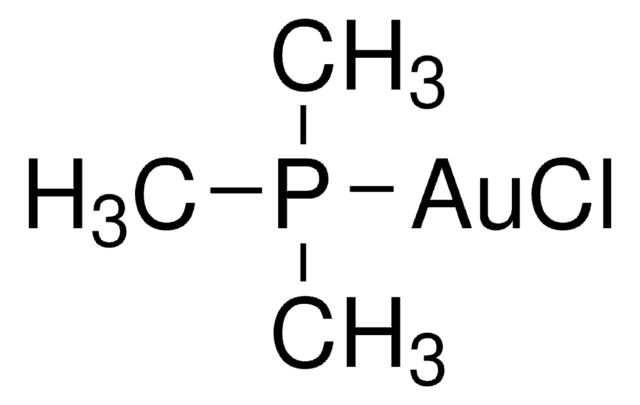If this product has an expiration or retest date, it will be shown on the Certificate of Analysis (COA, CofA). If there is no retest or expiration date listed on the product's COA, we do not have suitable stability data to determine a shelf life. For these products, the only date on the COA will be the release date; a retest, expiration, or use-by-date will not be displayed.
For all products, we recommend handling per defined conditions as printed in our product literature and website product descriptions. We recommend that products should be routinely inspected by customers to ensure they perform as expected.
For products without retest or expiration dates, our standard warranty of 1 year from the date of shipment is applicable.
For more information, please refer to the Product Dating Information document: https://www.sigmaaldrich.com/deepweb/assets/sigmaaldrich/marketing/global/documents/449/386/product-dating-information-mk.pdf
Wichtige Dokumente
481130
Gold(I)-chlorid
99.9% trace metals basis
Synonym(e):
Aurous chloride, Gold monochloride
Größe auswählen
About This Item
Empfohlene Produkte
Qualität
for analytical purposes
Qualitätsniveau
Assay
99.9% trace metals basis
Form
powder
Eignung der Reaktion
reagent type: catalyst
core: gold
Verunreinigungen
≤1500 ppm Trace Metal Analysis
mp (Schmelzpunkt)
289 °C (dec.) (lit.)
Dichte
7.57 g/mL at 25 °C (lit.)
SMILES String
[Cl-].[Au+]
InChI
1S/Au.ClH/h;1H/q+1;/p-1
InChIKey
FDWREHZXQUYJFJ-UHFFFAOYSA-M
Suchen Sie nach ähnlichen Produkten? Aufrufen Leitfaden zum Produktvergleich
Verwandte Kategorien
Allgemeine Beschreibung
Anwendung
- As a precursor to prepare magnetic nanocatalyst systems for various organic transformations. For example, Fe3O4@SiO2-P–AuCl can be used as a catalyst for one-pot reductive amination of aldehydes and ketones with various aromatic amines.[1]
- As a starting material to synthesize Au-containing complexes for application in the field of drug delivery, solar cells, sensors, and organic synthesis.[2]
- As a precatalyst for stereoselective cycloisomerization of α-thioallenes to 2,5-dihydrothiophenes via C-S bond formation.[3]
- As a catalyst for the conversion of siloxy cyclohexadienes, to the corresponding1,2- and 1,3-cyclohexenones via Gold-Catalyzed Cycloisomerization.[4]
Signalwort
Danger
H-Sätze
Gefahreneinstufungen
Skin Corr. 1B - Skin Sens. 1
Lagerklassenschlüssel
8A - Combustible corrosive hazardous materials
WGK
WGK 3
Flammpunkt (°F)
Not applicable
Flammpunkt (°C)
Not applicable
Persönliche Schutzausrüstung
Eyeshields, Faceshields, Gloves, type P3 (EN 143) respirator cartridges
Hier finden Sie alle aktuellen Versionen:
Analysenzertifikate (COA)
Die passende Version wird nicht angezeigt?
Wenn Sie eine bestimmte Version benötigen, können Sie anhand der Lot- oder Chargennummer nach einem spezifischen Zertifikat suchen.
Besitzen Sie dieses Produkt bereits?
In der Dokumentenbibliothek finden Sie die Dokumentation zu den Produkten, die Sie kürzlich erworben haben.
Kunden haben sich ebenfalls angesehen
Artikel
Access gold precatalysts, silver salts, and unsaturated building blocks to accelerate research success in catalysis applications.
Plasmonic nanoparticles have unique optical properties that can be tailored to suit a variety of applications in the biotechnology1–8 and electronics9–16 industries.
-
How can I determine the shelf life / expiration / retest date of this product?
1 answer-
Helpful?
-
-
How is shipping temperature determined? And how is it related to the product storage temperature?
1 answer-
Products may be shipped at a different temperature than the recommended long-term storage temperature. If the product quality is sensitive to short-term exposure to conditions other than the recommended long-term storage, it will be shipped on wet or dry-ice. If the product quality is NOT affected by short-term exposure to conditions other than the recommended long-term storage, it will be shipped at ambient temperature. As shipping routes are configured for minimum transit times, shipping at ambient temperature helps control shipping costs for our customers. For more information, please refer to the Storage and Transport Conditions document: https://www.sigmaaldrich.com/deepweb/assets/sigmaaldrich/marketing/global/documents/316/622/storage-transport-conditions-mk.pdf
Helpful?
-
Active Filters
Unser Team von Wissenschaftlern verfügt über Erfahrung in allen Forschungsbereichen einschließlich Life Science, Materialwissenschaften, chemischer Synthese, Chromatographie, Analytik und vielen mehr..
Setzen Sie sich mit dem technischen Dienst in Verbindung.









![[(IPr)AuCl] Umicore](/deepweb/assets/sigmaaldrich/product/structures/186/572/1f89dfca-fb52-46a2-9c9d-96db67c22883/640/1f89dfca-fb52-46a2-9c9d-96db67c22883.png)
